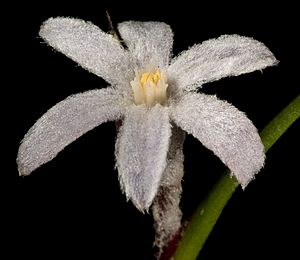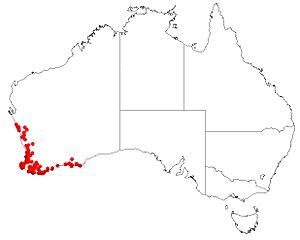Tribonanthes violacea facts for kids
Quick facts for kids Tribonanthes violacea |
|
|---|---|
 |
|
| Scientific classification | |
| Genus: |
Tribonanthes
|
| Species: |
violacea
|
 |
|
| Collection data for T. violacea from the Australasian Virtual Herbarium | |
Tribonanthes violacea is a small, beautiful plant that belongs to the Tribonanthes group. It's part of the bloodwort family, called Haemodoraceae. A scientist named Stephan Endlicher first described this plant in 1846.
This plant is a perennial herb, which means it's a small plant without a woody stem that lives for more than two years. It usually grows to be about 5 to 20 centimeters (2 to 8 inches) tall. You can spot its lovely white to purple flowers between July and October.
Contents
About the Purple Bloodwort
Tribonanthes violacea is a fascinating plant with unique features. It's known for its pretty flowers and specific growing habits.
What Does It Look Like?
This plant is quite small, reaching only up to 20 centimeters high. It's a type of herb, meaning it doesn't have a hard, woody stem like a tree or bush. Its flowers are a beautiful sight, ranging from white to purple. They bloom during the cooler months, from late winter into spring.
Where Does It Grow?
Tribonanthes violacea likes to grow in certain types of soil and places. You can find it in areas that get wet during some parts of the year. It also grows on or near large granite rocks.
Preferred Habitats
This plant prefers different kinds of soil. These include:
- Peat (a type of soil made from decayed plants)
- White, grey, or yellow sands
- Clay loams (a mix of clay, sand, and silt)
- Areas with granite rocks
It especially thrives in places that are seasonally wet. This means they get a lot of water during certain times of the year, like after rain.
Regions in Australia
You can find Tribonanthes violacea in several special areas in Western Australia. These areas are part of what scientists call the IBRA regions. IBRA stands for Interim Biogeographic Regionalisation for Australia. It helps us understand different natural environments.
The regions where this plant grows include:
- Avon Wheatbelt
- Esperance Plains
- Geraldton Sandplains
- Jarrah Forest
- Swan Coastal Plain
- Warren
These regions each have their own unique climate and soil, but they all provide the right conditions for Tribonanthes violacea to grow.

